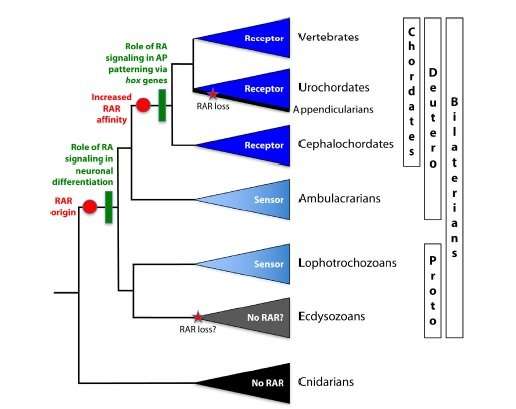This molecule is an essential factor in chordates to regulate the expression of genes involved in processes of cell proliferation and differentiation. Credit: Universidad de Barcelona
In molecular biology, retinoic acid plays a key role in signalling pathways in the embryonic development of vertebrates. However, not much is known about its origins in the metazoan evolution. An international team has described for the first time the ancestral function of retinoic acid in the lineage of animals with bilateral symmetry, according to an article published in the journal Science Advances.
Retinoic acid (RA) is an important molecule in the physiology and embryonic development of the phylogenetic line of chordates. Derived from vitamin A (retinol), it is a necessary factor to regulate the gene expression in cell proliferation and differentiation during the embryonic development and the formation of body symmetry patterns.
Looking for ancient genetic machinery
The new study reveals that the primary function of retinoic acid was to control cell differentiation and to ease the creation of neurons in the right place and time. Lecturer Ricard Albalat says, "Through the analysis of genomic data, we were the first to describe the existence of the genetic machinery of this signalling outside the chordate phylogenetic line."
The enzymes that control the levels of retinoic acid and the nuclear receptors that respond to the signal and regulate genetic transcription are ancestral. "Our studies, however, did not show whether the signaling function was the same, or if it had changed during evolution, or whether it regulated similar or different biological processes in the different species," says Albalat, lecturer from the Department of Genetics, Microbiology and Statistics of the UB.
The multidisciplinary researchers accepted the challenge of describing the signalling of the retinoic acid pathway in a protostome organism. "The most common protostome models such as Drosophila or Caenorhabditis were not an option, since they had lost this biochemical pathway. Therefore, it was necessary to find a protostome species that had preserved the machinery of retinoic acid and which could undergo functional studies," says Albalat.
The worm Platynereis dumerilii, an annelid regarded as a living fossil, was a good candidate as a model in studies on evolution, development and neurobiology, since all components of the pathways were conserved in this species. With the scientific database on this organism, the researchers could identify and classify the elements of the genetic machinery, aiming to find the necessary genes to study in order to describe the functioning of the pathway.
With the analysis of the expression patterns of the selected genes and the evaluation of the morphological effects of its alteration with morpholino or treatments with exogenous retinoic acid, the researchers could show that retinoic acid controlled cell differentiation in the species P. dumerilii and eased the proper formation of neurons, according to the authors.
"We think this neurogenic role represents the ancestral function of the retinoic acid in bilateral animals. Therefore, its evolutionary origin would coincide with the appearance of several components of the machinery of this evolutionary lineage, such as the retinoic acid receptor (RAR) and the cytochrome Cyp26," says Albalat.
The new study is published in the journal Science Advances. In previous studies, the Evo-Devo-Genomics Research Group (UB-IRBio) described the loss of retinoic acid-related genes in a situation of regressive evolution in some model species. "Everything suggests that the RA machinery is a genetically though system. In humans, we know many enzymes that regulate the synthesis and degradation of RA. Understanding how this system evolved and how these enzymes work is important for our health," concludes the researcher.
More information: Mette Handberg-Thorsager et al. The ancestral retinoic acid receptor was a low-affinity sensor triggering neuronal differentiation, Science Advances (2018). DOI: 10.1126/sciadv.aao1261
Journal information: Science Advances
Provided by University of Barcelona





















